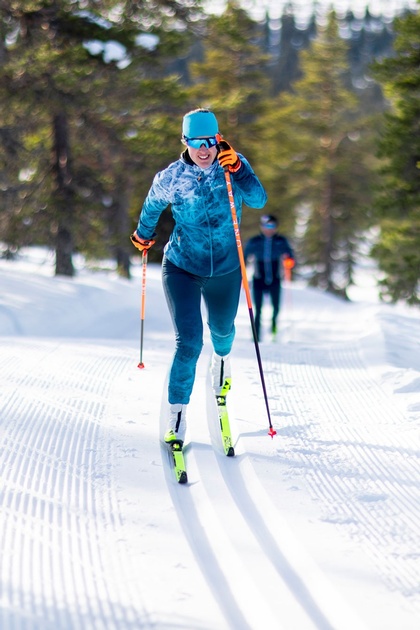
On your skins, get set, go!
Photo: IMAGO
A multitude of skin skis allow easy classic cross-country skiing without the need for wax. The key points.
In recent years, the (re)emergence of skin skis has changed the classic cross-country ski scene. The diagonal style is increasing in popularity, primarily amongst runners who have been focussing more on skating and want to forgot the hassle of waxing.
For runners, classic cross-country skiing far closer resembles the motion of running than skating due to the nature of the push off and the arm and leg movements.
Adapted models
The motto for the new generation of skin skis is ‘Click & Run'. All the manufacturers are now offering at least two or more models for the favour of classic cross-country skiers.
There are skin skis for beginners, intermediate skiers and even racers. The manufacturers design the skis according to performance and weight category with varying degrees of flex and hardness. This allows the kick zone to be perfectly adapted to the specific conditions.
Skin skis are similar in design to classic waxed skis and are just as good in terms of their dynamic characteristics. Many sports models often involve attaching two thin strips of skin, slightly offset from each other, whereas one skin with a larger surface area is preferred for all-round use. The more impulsive and precise the kick-off, the smaller the skin surface should be. The advantage of this is minimal interference from the skin during the glide phase.
The skins are good for 800-1000 kilometres. However, the lifespan of the skins depends not only on the distance covered but also the skier’s proficiency level and snow characteristics. Hard-packed or icy pistes place more wear on the skins than deep, fresh snow. Specialists can roughen and replace worn-out skins.
The climbing and gliding properties of skin skis can be further improved by using an additional trick: most skin skis now have adjustable bindings. If more grip is required during the kick-off phase (e.g. for longer ascents), the binding can be moved forwards slightly, whereas if more glide is required in order to ski faster (for longer flat sections or descents) then the binding can be moved backwards with a simple click and no need for any tools.
Easy maintenance
Similar to touring skis, classic cross-country skin skis are made of either pure mohair or synthetic/blended fabric. In principle, the more mohair, the faster the ski as mohair both absorbs moisture and is water-repellent, making the ski glide faster.
Caring for skin skis is as easy as using them. It is advisable to coat the skin every 2-3 times with a water-repellent skin spray. As with skating or classic waxed skis, the glide zone (back and front) should be regularly treated and maintained with glide wax. All specialist stores offer this service.
Anyone toying with the idea of expanding their repertoire with classic cross-country skiing should definitely give this a try at least once. Even staunch skaters can combine the benefits of both styles with skin skis.
To get started, you can rent skis from any winter sports shop. If you are looking to buy skin skis, you'll find all-round models from around 300 francs and high-end, lightweight carbon fibre skis for up to 600 francs.
This may be of interest for you too


